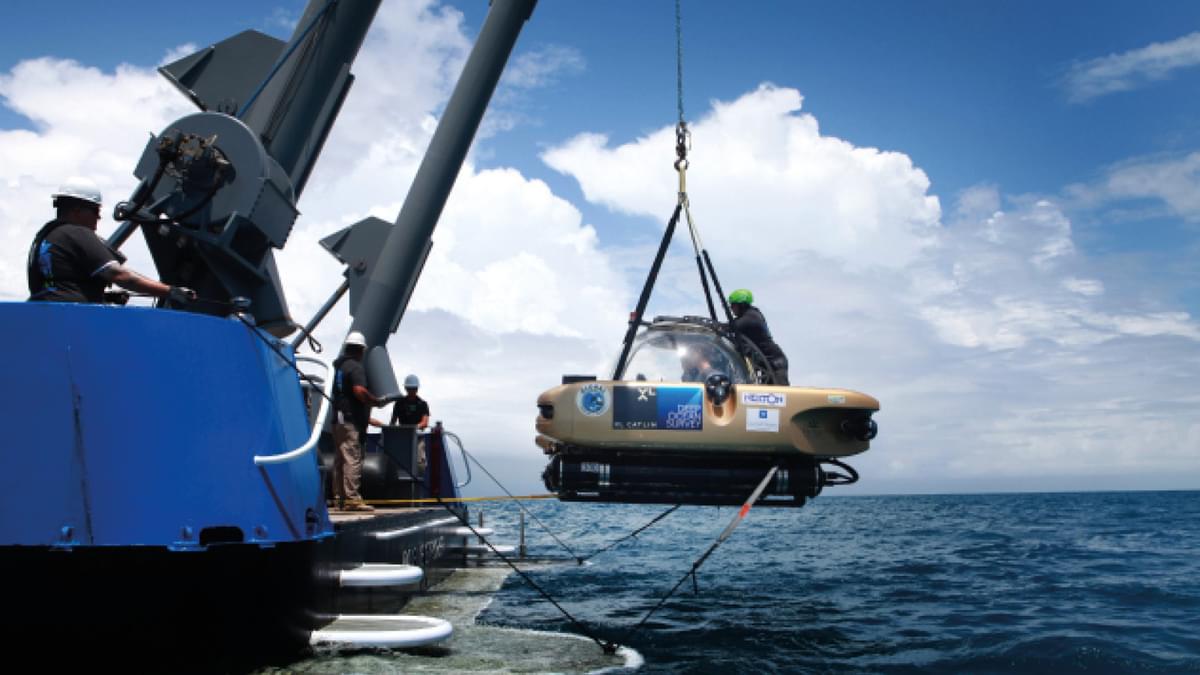
Submarine shape
In this activity students use different shapes of modelling clay to find a shape that will take exactly seven seconds to fall through a cylinder of water. Students will learn about water resistance and why submarines and submersibles are particular shapes.
Preparation
Prepare your resources, each group will need, modelling clay, a large measuring cylinder (at least 250ml), access to water, a tray, a stopwatch, a sieve or strainer and access to a digital balance. Before the session ensure your cylinder is filled with water and you have chosen a mass of modelling clay you want to use.
Session steps
1. Introduction (5 mins)
Jamie will open the session with a welcome and brief introduction to the expedition and any shout-outs to registered classes.
In this activity students will observe the importance of the shape of a submarine and how that is important to the success of submarines.
2. Subject knowledge (10 mins)
Jamie will then explain that this activity is all about fluid dynamics. When you are assessing the different shapes and the time they take to fall through the water, you will need to consider the shape and mass of the modelling clay model.
3. Activity time (15 mins)
Jamie will then begin demonstrating the activity and students can follow along in real-time. The practical investigation involves dropping different shapes made from modelling clay into a cylinder of water. The time taken for the shape to fall through the water will depend on the mass of the modelling clay and the size of the cylinder.
The activity should be partially set up with the cylinder full of water and the modelling clay masses already weighed out. Mark a finishing point on the cylinder above the bottom. This allows space at the bottom of the cylinder for previous clay shapes to collect without getting in the way of further tries.
To begin make a shape out of the modelling clay, ensure it is small enough so that it can fall through the cylinder without hitting the sides. Hold the modelling clay just touching the top of the water. Ensure that each shape is released at the same point in the water – just touching the surface rather than above it. This will prevent the shape having a chance to accelerate in the air before hitting the water, which will affect the results. Repeat the experiment, changing the shape to speed it up or slow it down accordingly.
At this point, you can submit your students’ questions via the live chat.
4. Q&A and conclusion (15 mins)
After completing the activity Jamie will be able to answer pre-submitted questions and take part in the live chat. At the end of the broadcast, Jamie will suggest some other activities you might like to try and what's coming up in the rest of Submarine Live 2019.
Speakers

Jamie Buchanan-Dunlop
Executive Director, Encounter Edu
Brought to you by


Submarine shape
In this activity students use different shapes of modelling clay to find a shape that will take exactly seven seconds to fall through a cylinder of water. Students will learn about water resistance and why submarines and submersibles are particular shapes.
Preparation
Prepare your resources, each group will need, modelling clay, a large measuring cylinder (at least 250ml), access to water, a tray, a stopwatch, a sieve or strainer and access to a digital balance. Before the session ensure your cylinder is filled with water and you have chosen a mass of modelling clay you want to use.
Session steps
1. Introduction (5 mins)
Jamie will open the session with a welcome and brief introduction to the expedition and any shout-outs to registered classes.
In this activity students will observe the importance of the shape of a submarine and how that is important to the success of submarines.
2. Subject knowledge (10 mins)
Jamie will then explain that this activity is all about fluid dynamics. When you are assessing the different shapes and the time they take to fall through the water, you will need to consider the shape and mass of the modelling clay model.
3. Activity time (15 mins)
Jamie will then begin demonstrating the activity and students can follow along in real-time. The practical investigation involves dropping different shapes made from modelling clay into a cylinder of water. The time taken for the shape to fall through the water will depend on the mass of the modelling clay and the size of the cylinder.
The activity should be partially set up with the cylinder full of water and the modelling clay masses already weighed out. Mark a finishing point on the cylinder above the bottom. This allows space at the bottom of the cylinder for previous clay shapes to collect without getting in the way of further tries.
To begin make a shape out of the modelling clay, ensure it is small enough so that it can fall through the cylinder without hitting the sides. Hold the modelling clay just touching the top of the water. Ensure that each shape is released at the same point in the water – just touching the surface rather than above it. This will prevent the shape having a chance to accelerate in the air before hitting the water, which will affect the results. Repeat the experiment, changing the shape to speed it up or slow it down accordingly.
At this point, you can submit your students’ questions via the live chat.
4. Q&A and conclusion (15 mins)
After completing the activity Jamie will be able to answer pre-submitted questions and take part in the live chat. At the end of the broadcast, Jamie will suggest some other activities you might like to try and what's coming up in the rest of Submarine Live 2019.
Speakers

Jamie Buchanan-Dunlop
Executive Director, Encounter Edu
Brought to you by



